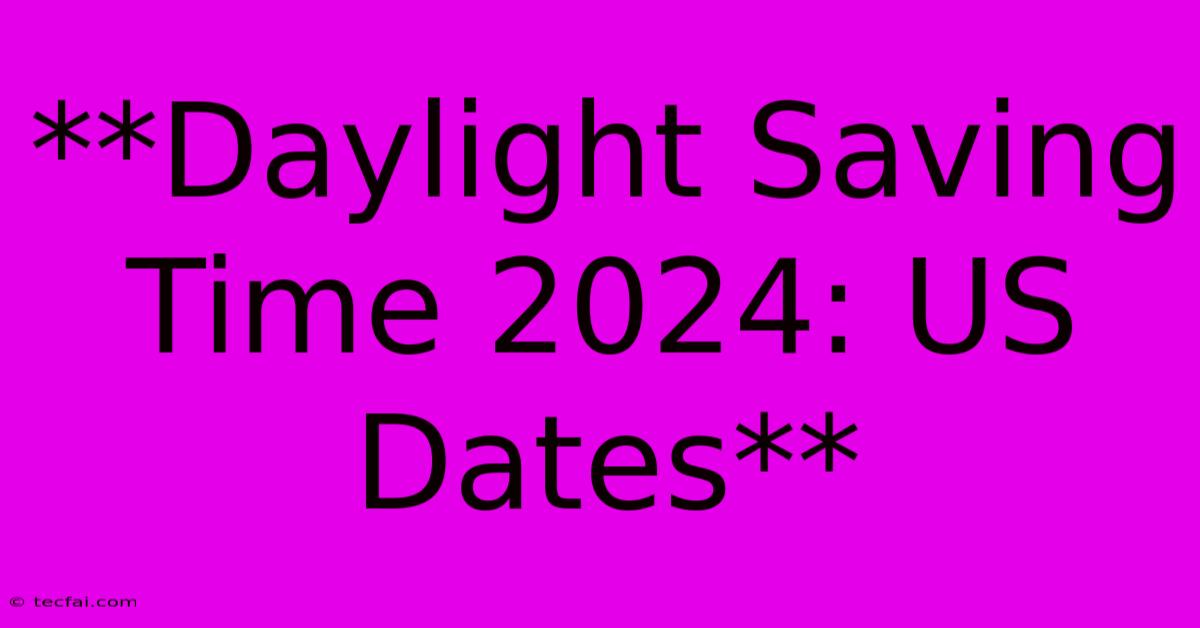**Daylight Saving Time 2024: US Dates**

Discover more detailed and exciting information on our website. Click the link below to start your adventure: Visit Best Website tecfai.com. Don't miss out!
Table of Contents
Daylight Saving Time 2024: US Dates and What You Need to Know
Daylight Saving Time (DST) is a familiar annual adjustment, but it can still throw us off when it comes to knowing when to change our clocks. As we approach the spring and fall transitions, it's helpful to have the exact dates for 2024.
Here's a breakdown of the US Daylight Saving Time dates for 2024:
Spring Forward: Daylight Saving Time Begins
Sunday, March 10, 2024, at 2:00 AM
On this date, most of the United States will "spring forward" by moving their clocks ahead one hour. This means we will lose an hour of sleep but gain an extra hour of daylight in the evenings.
Fall Back: Daylight Saving Time Ends
Sunday, November 3, 2024, at 2:00 AM
On this date, we will "fall back" by setting our clocks back one hour. This means we'll gain an hour of sleep but lose an hour of daylight in the evenings.
Who Follows Daylight Saving Time?
Most of the United States participates in Daylight Saving Time. However, there are a few exceptions:
- Arizona: Arizona does not observe Daylight Saving Time and remains on Mountain Standard Time year-round.
- Hawaii: Hawaii also does not observe Daylight Saving Time and remains on Hawaii Standard Time year-round.
Tips for Adjusting to Daylight Saving Time
The change to Daylight Saving Time can affect our sleep patterns and overall well-being. Here are a few tips to help you adjust:
- Adjust your sleep schedule gradually: In the days leading up to the time change, try going to bed and waking up 15 minutes earlier or later each day.
- Avoid caffeine and alcohol before bed: These substances can interfere with sleep quality.
- Get plenty of sunlight: Natural light helps regulate your body's sleep-wake cycle.
- Stay hydrated: Dehydration can contribute to fatigue.
The Future of Daylight Saving Time
There has been a growing movement in recent years to make Daylight Saving Time permanent year-round. This would eliminate the biannual clock changes and provide more daylight hours in the evenings during the winter. The future of Daylight Saving Time remains uncertain, but it's something to watch for in the coming years.
By understanding the dates and potential impact of Daylight Saving Time, you can be better prepared to navigate these annual adjustments.

Thank you for visiting our website wich cover about **Daylight Saving Time 2024: US Dates**. We hope the information provided has been useful to you. Feel free to contact us if you have any questions or need further assistance. See you next time and dont miss to bookmark.
Featured Posts
-
Son Honors Father Killed In Sydney Plane Crash
Oct 28, 2024
-
New Zombie Era Gen Zs Spin On The Dead
Oct 28, 2024
-
The Voice Uk Fan Wishes For Next Season
Oct 28, 2024
-
Timog Korea 1 8 Gw Wind Power Bidding
Oct 28, 2024
-
Na Linis Na Ang St Marys Rd Cemetery Para Sa Undas
Oct 28, 2024
